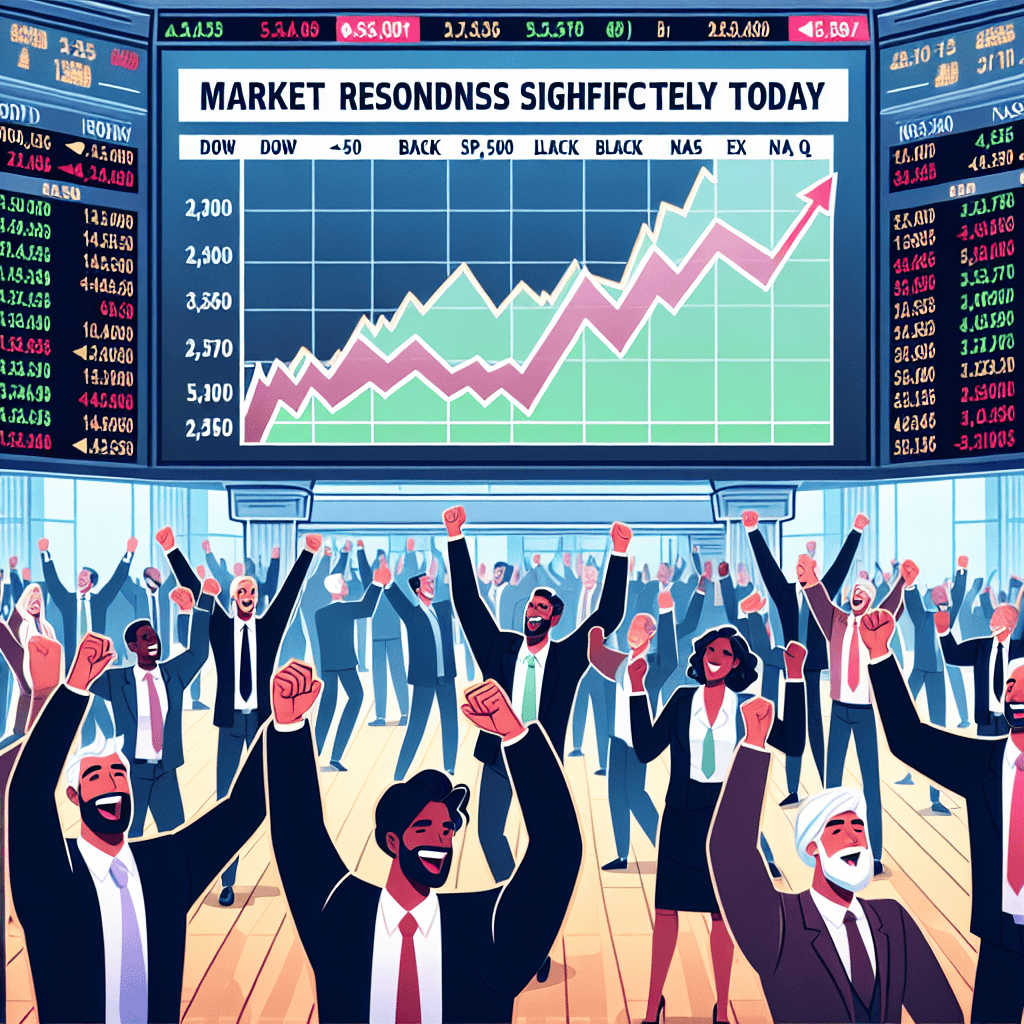“Markets Rally: Dow, S&P 500, Nasdaq Soar as Election Day Kicks Off”
Introduction
As Election Day unfolds, the stock market is experiencing a significant rebound, with major indices such as the Dow Jones Industrial Average, the S&P 500, and the Nasdaq Composite all showing substantial gains. This surge reflects investor optimism and market anticipation surrounding the potential outcomes of the elections, which could have far-reaching implications for economic policy and market dynamics. The rally underscores the market’s sensitivity to political developments and the broader economic landscape, as traders and investors position themselves in response to the evolving electoral narrative. As the day progresses, market participants will be closely monitoring election results and their potential impact on future fiscal and regulatory policies.
Analyzing Historical Election Day Stock Market Trends
As Election Day unfolds, the stock market is experiencing a notable surge, with the Dow Jones Industrial Average, the S&P 500, and the Nasdaq Composite all showing significant gains. This upward momentum is not entirely unexpected, as historical trends often reveal a pattern of market fluctuations around election periods. Understanding these trends can provide valuable insights into the current market dynamics and help investors make informed decisions.
Historically, the stock market has exhibited varied responses to election outcomes, often influenced by the perceived economic policies of the candidates. Typically, markets prefer certainty, and the conclusion of an election can reduce uncertainty, leading to a rally. For instance, in the days leading up to an election, markets may experience volatility as investors react to polls and potential policy shifts. However, once the results are clear, markets often stabilize and, in many cases, rally as investors adjust their portfolios to align with the anticipated economic environment.
Moreover, the stock market’s performance on Election Day itself can be influenced by several factors, including investor sentiment and expectations about the election’s outcome. Historically, when investors anticipate a clear winner, markets tend to react positively, reflecting confidence in the future economic direction. Conversely, if the election is expected to be contentious or if there is uncertainty about the results, markets may react with caution, leading to subdued performance or increased volatility.
In examining past election cycles, it is evident that the stock market’s response is not solely dependent on which political party wins. Instead, the market’s reaction is often more closely tied to the anticipated economic policies and their potential impact on corporate earnings and economic growth. For example, markets may respond favorably to candidates who propose policies perceived as business-friendly, such as tax cuts or deregulation, as these measures can boost corporate profits and stimulate economic activity.
Furthermore, the broader economic context during an election year can also play a significant role in shaping market trends. Economic indicators such as GDP growth, unemployment rates, and inflation can influence investor sentiment and market performance. In years where the economy is strong, markets may be more resilient to election-related uncertainties. Conversely, in times of economic downturn, elections can exacerbate market volatility as investors weigh the potential for policy changes to address economic challenges.
As we observe the current surge in the Dow, S&P 500, and Nasdaq, it is essential to consider these historical patterns and the underlying factors driving market movements. While the immediate reaction may be influenced by investor sentiment and expectations, the longer-term impact will depend on the actual policies implemented by the elected officials and their effectiveness in addressing economic issues.
In conclusion, while historical trends provide a framework for understanding stock market behavior during election periods, each election cycle is unique, shaped by its specific economic and political context. As such, investors should remain vigilant, considering both historical patterns and current developments to navigate the complexities of the market during this pivotal time. By doing so, they can better position themselves to capitalize on opportunities and mitigate risks as the election unfolds and its implications for the economy become clearer.
Factors Driving the Dow’s Election Day Surge
As Election Day unfolds, the stock market is experiencing a notable rebound, with the Dow Jones Industrial Average, S&P 500, and Nasdaq Composite all showing significant gains. This surge can be attributed to a confluence of factors that have instilled a sense of optimism among investors. Understanding these driving forces provides insight into the current market dynamics and the potential implications for the future.
Firstly, investor sentiment has been buoyed by the anticipation of a clear electoral outcome. Historically, markets have shown a preference for certainty, and the prospect of a decisive result reduces the risk of prolonged political uncertainty. This clarity is crucial for investors who are eager to make informed decisions based on predictable policy directions. As a result, the market is responding positively to the possibility of a smooth transition of power, regardless of the election’s outcome.
In addition to the political landscape, economic indicators have played a pivotal role in the market’s resurgence. Recent data releases have painted a picture of a resilient economy, with key metrics such as employment figures and consumer spending showing signs of recovery. These indicators suggest that the economic impact of the pandemic may be waning, providing a foundation for renewed investor confidence. Moreover, the Federal Reserve’s commitment to maintaining accommodative monetary policies has further bolstered market sentiment. By keeping interest rates low and continuing asset purchases, the Fed has signaled its readiness to support economic growth, thereby encouraging investment in equities.
Furthermore, corporate earnings have exceeded expectations, contributing to the market’s upward trajectory. Many companies have reported robust third-quarter results, reflecting their ability to adapt to challenging conditions and capitalize on emerging opportunities. This resilience has reassured investors about the underlying strength of the corporate sector, prompting a re-evaluation of stock valuations. As companies continue to demonstrate their capacity for innovation and growth, the market is likely to remain buoyant.
Another factor influencing the market’s performance is the global economic environment. International markets have shown signs of stabilization, with major economies gradually recovering from the disruptions caused by the pandemic. This global recovery has positive implications for U.S. companies with international exposure, as it suggests an increase in demand for goods and services. Consequently, investors are optimistic about the potential for revenue growth in sectors that are heavily reliant on global trade.
Moreover, technological advancements and the accelerated adoption of digital solutions have provided a tailwind for the Nasdaq Composite, which is heavily weighted towards technology stocks. The pandemic has accelerated trends such as remote work, e-commerce, and digital payments, creating new opportunities for tech companies. As these trends continue to evolve, they are likely to drive sustained growth in the technology sector, further supporting the market’s overall performance.
In conclusion, the stock market’s Election Day surge is the result of a complex interplay of factors, including political clarity, positive economic indicators, strong corporate earnings, global economic recovery, and technological innovation. While uncertainties remain, particularly regarding the long-term effects of the pandemic and geopolitical tensions, the current market environment reflects a cautious optimism. Investors are navigating these dynamics with an eye towards future opportunities, and the market’s resilience suggests that it is well-positioned to weather potential challenges. As the election results unfold, the focus will likely shift to policy implications and their impact on the economic landscape, shaping the market’s trajectory in the months to come.
The Role of Political Uncertainty in S&P 500 Volatility
As Election Day unfolds, the stock market is experiencing a notable rebound, with the Dow Jones Industrial Average, S&P 500, and Nasdaq Composite all showing significant gains. This surge comes amid a backdrop of political uncertainty, a factor that has historically played a crucial role in influencing market volatility, particularly for the S&P 500. Political events, especially elections, often introduce a level of unpredictability that can lead to fluctuations in investor sentiment and market performance. The S&P 500, a broad measure of the U.S. stock market, is particularly sensitive to such uncertainties due to its composition of diverse sectors that are directly impacted by government policies and regulations.
Political uncertainty can manifest in various forms, including changes in fiscal policy, regulatory shifts, and geopolitical tensions, all of which can have profound implications for corporate earnings and economic growth. As investors attempt to anticipate the outcomes of elections and their potential impact on the business environment, market volatility tends to increase. This is especially true in the weeks leading up to an election, as polls and debates shape expectations and influence trading behavior. The S&P 500, with its wide array of constituent companies, often reflects these anticipations, resulting in heightened volatility.
Moreover, the relationship between political uncertainty and market volatility is not solely confined to domestic elections. Global political events, such as trade negotiations and international conflicts, can also contribute to market fluctuations. For instance, the S&P 500 has previously reacted to trade tensions between major economies, as these disputes can affect global supply chains and corporate profitability. In such scenarios, investors may adopt a cautious approach, leading to increased market volatility as they reassess their portfolios in light of potential risks and opportunities.
Despite the challenges posed by political uncertainty, it is important to recognize that markets are inherently forward-looking. Investors often attempt to price in expected outcomes before they materialize, which can lead to periods of volatility followed by stabilization once the uncertainty is resolved. This forward-looking nature of markets is evident in the current rebound, as investors appear to be gaining confidence in the potential for favorable election outcomes that could support economic growth and corporate earnings.
Furthermore, it is worth noting that while political uncertainty can drive short-term volatility, it does not necessarily dictate long-term market trends. Historical data suggests that the S&P 500 has demonstrated resilience in the face of political upheaval, often recovering and continuing its upward trajectory over time. This resilience is attributed to the underlying strength of the U.S. economy and the adaptability of businesses to changing political landscapes.
In conclusion, as Election Day progresses and the stock market rebounds, the role of political uncertainty in influencing S&P 500 volatility remains a critical consideration for investors. While such uncertainty can lead to short-term fluctuations, the market’s forward-looking nature and historical resilience provide a measure of reassurance. As investors navigate this period of political change, they must weigh the potential risks and opportunities, keeping in mind that while political events can impact market dynamics, they are but one of many factors that shape the broader economic landscape.
Nasdaq’s Performance: Tech Stocks Leading the Charge

As Election Day unfolds, the stock market is experiencing a notable rebound, with the Nasdaq leading the charge among major indices. This resurgence is largely driven by the robust performance of technology stocks, which have been pivotal in propelling the Nasdaq to new heights. The tech-heavy index has consistently demonstrated resilience, even amid broader market volatility, underscoring the sector’s critical role in the current economic landscape.
The Nasdaq’s impressive performance can be attributed to several key factors. First and foremost, the technology sector has been at the forefront of innovation, driving significant advancements in areas such as artificial intelligence, cloud computing, and cybersecurity. These innovations have not only transformed industries but have also created new opportunities for growth and investment. As a result, tech companies have attracted substantial investor interest, contributing to the Nasdaq’s upward trajectory.
Moreover, the ongoing digital transformation across various sectors has further bolstered the demand for technology solutions. Businesses and consumers alike have increasingly relied on digital platforms and services, a trend that has been accelerated by the global pandemic. This shift has provided a fertile ground for tech companies to expand their offerings and capture a larger market share, thereby enhancing their financial performance and stock valuations.
In addition to these industry-specific dynamics, broader economic factors have also played a role in the Nasdaq’s resurgence. The Federal Reserve’s accommodative monetary policy, characterized by low interest rates and quantitative easing measures, has created a favorable environment for equities, particularly growth-oriented stocks like those in the tech sector. Investors, in search of higher returns, have gravitated towards these stocks, further fueling the Nasdaq’s ascent.
Furthermore, the anticipation of potential policy changes following the election has injected a sense of optimism into the market. Investors are closely monitoring the election outcomes, as they could have significant implications for regulatory and fiscal policies affecting the technology sector. A favorable policy environment could pave the way for continued innovation and expansion, reinforcing the sector’s leadership in the market.
While the Nasdaq’s performance is undoubtedly impressive, it is important to acknowledge the inherent risks associated with investing in technology stocks. The sector is characterized by rapid changes and intense competition, which can lead to volatility. Additionally, valuations in the tech sector have reached elevated levels, prompting concerns about potential corrections. Investors must remain vigilant and consider these factors when making investment decisions.
Nevertheless, the current momentum in the Nasdaq reflects a broader confidence in the technology sector’s ability to drive economic growth and innovation. As Election Day progresses, market participants will continue to assess the evolving political landscape and its potential impact on the tech industry. In the meantime, the Nasdaq’s strong performance serves as a testament to the enduring appeal of technology stocks and their pivotal role in shaping the future of the global economy.
In conclusion, as the stock market rebounds on Election Day, the Nasdaq stands out as a key driver of this resurgence, propelled by the strength of technology stocks. The sector’s innovative capabilities, coupled with favorable economic conditions and policy expectations, have positioned it as a leader in the market. While challenges remain, the Nasdaq’s performance underscores the critical importance of technology in the modern economy and its potential to continue leading the charge in the years to come.
Investor Sentiment and Its Impact on Market Rebounds
Investor sentiment plays a crucial role in the dynamics of stock market movements, often acting as a barometer for the broader economic outlook. As Election Day commences, the stock market has shown a remarkable rebound, with the Dow Jones Industrial Average, S&P 500, and Nasdaq Composite all experiencing significant surges. This upward momentum can be attributed to a confluence of factors, primarily driven by investor sentiment, which has shifted positively in anticipation of potential policy changes and economic stability.
To understand the impact of investor sentiment on market rebounds, it is essential to consider the psychological factors that influence trading behavior. Investors, both institutional and retail, often react to political events with a mix of optimism and caution. The prospect of a new administration or the continuation of an existing one can lead to expectations of policy shifts that may affect taxation, regulation, and government spending. These expectations, in turn, influence investment decisions, as market participants adjust their portfolios to align with perceived future economic conditions.
Moreover, the stock market’s recent surge can be seen as a reflection of investor confidence in the resilience of the economy. Despite the uncertainties that typically accompany election periods, there is a prevailing belief that the underlying fundamentals of the economy remain strong. This confidence is bolstered by positive economic indicators, such as robust employment figures and steady consumer spending, which suggest that the economy is on a stable footing. Consequently, investors are more willing to take on risk, leading to increased buying activity and upward pressure on stock prices.
In addition to domestic factors, global economic conditions also play a role in shaping investor sentiment. As the world becomes increasingly interconnected, developments in international markets can have a profound impact on U.S. stock indices. For instance, signs of economic recovery in major economies, such as the European Union and China, can enhance investor confidence, as they suggest a more favorable global trade environment. This interconnectedness means that positive news abroad can amplify the effects of domestic optimism, further fueling market rebounds.
Furthermore, the role of technology and innovation cannot be overlooked in the context of market movements. The Nasdaq, in particular, has benefited from the strong performance of technology stocks, which have become a cornerstone of modern economic growth. As investors anticipate continued advancements in areas such as artificial intelligence, renewable energy, and biotechnology, there is a growing appetite for tech-related investments. This enthusiasm contributes to the overall buoyancy of the stock market, as technology companies are often seen as drivers of future economic expansion.
While investor sentiment is a powerful force in driving market rebounds, it is important to recognize that it is not the sole determinant of stock market performance. Other factors, such as monetary policy, fiscal stimulus measures, and geopolitical developments, also play significant roles. However, the current surge in the Dow, S&P 500, and Nasdaq underscores the importance of sentiment as a catalyst for market movements. As Election Day unfolds, investors will continue to monitor political developments closely, with the hope that the outcome will provide clarity and direction for future economic policies.
In conclusion, the recent rebound in the stock market highlights the intricate relationship between investor sentiment and market performance. As investors navigate the complexities of the election period, their collective optimism has contributed to a surge in major stock indices. This phenomenon underscores the importance of understanding the psychological and economic factors that drive market behavior, as they provide valuable insights into the potential trajectory of the financial markets.
Comparing Current Market Rebounds to Past Election Cycles
As Election Day unfolds, the stock market is experiencing a notable rebound, with the Dow Jones Industrial Average, S&P 500, and Nasdaq Composite all showing significant gains. This surge in the markets is drawing comparisons to past election cycles, where similar patterns of volatility and recovery have been observed. Historically, the stock market has often reacted to the uncertainty surrounding elections, with investors closely monitoring potential policy changes and their implications for economic growth. However, once the election results become clearer, markets tend to stabilize and, in many cases, rally as uncertainty diminishes.
To understand the current market rebound, it is essential to examine how previous election cycles have influenced market behavior. For instance, during the 2008 election, the financial crisis was at its peak, and the markets were highly volatile. However, following the election of President Barack Obama, the markets began to recover as investors gained confidence in the new administration’s economic policies. Similarly, in the 2016 election, the unexpected victory of President Donald Trump initially caused a sharp decline in futures markets. Yet, as investors anticipated pro-business policies, the markets quickly rebounded, leading to a prolonged period of growth.
In the current election cycle, several factors are contributing to the market’s positive momentum. Firstly, the anticipation of potential fiscal stimulus measures is providing a boost to investor sentiment. Both major political parties have proposed substantial spending plans aimed at supporting economic recovery, which investors view as a catalyst for growth. Additionally, the Federal Reserve’s commitment to maintaining low interest rates and providing liquidity to the financial system is further supporting market confidence.
Moreover, the ongoing recovery from the COVID-19 pandemic is playing a crucial role in shaping market dynamics. As vaccination rates increase and economic activity resumes, sectors that were heavily impacted by the pandemic, such as travel and hospitality, are beginning to show signs of recovery. This resurgence is contributing to the overall positive sentiment in the markets, as investors anticipate a return to pre-pandemic levels of economic activity.
While the current market rebound is encouraging, it is important to recognize that election cycles can also bring about periods of heightened volatility. The potential for contested election results or delays in vote counting could introduce uncertainty, leading to short-term fluctuations in the markets. However, historical trends suggest that such volatility is often temporary, with markets eventually stabilizing as clarity emerges.
In comparing the current market rebound to past election cycles, it is evident that while each election presents unique challenges and opportunities, certain patterns tend to repeat. The interplay between political developments, economic policies, and investor sentiment continues to shape market behavior. As Election Day progresses and results begin to unfold, investors will be closely watching for any indications of policy direction and potential impacts on various sectors.
In conclusion, the current surge in the Dow, S&P 500, and Nasdaq as Election Day begins is reflective of both historical patterns and present-day factors. While uncertainty remains a key theme, the market’s resilience and ability to rebound in the face of political and economic challenges underscore the complex relationship between elections and market dynamics. As investors navigate this period, understanding the lessons of past election cycles can provide valuable insights into potential future trends.
Strategies for Investors During Election-Induced Market Fluctuations
As Election Day unfolds, the stock market has shown a remarkable rebound, with the Dow Jones Industrial Average, S&P 500, and Nasdaq Composite all experiencing significant surges. This resurgence comes as a relief to investors who have been navigating the turbulent waters of election-induced market fluctuations. Understanding the strategies that can be employed during such volatile periods is crucial for investors aiming to safeguard their portfolios and capitalize on potential opportunities.
Firstly, it is essential for investors to maintain a long-term perspective. Election cycles are inherently temporary, and while they can cause short-term volatility, the broader market trends tend to stabilize over time. By focusing on long-term goals and maintaining a diversified portfolio, investors can mitigate the risks associated with sudden market swings. Diversification across various sectors and asset classes can help cushion the impact of volatility, as different segments of the market may react differently to political developments.
Moreover, investors should consider the importance of staying informed but not overreacting to daily market movements. The influx of news and predictions surrounding elections can lead to emotional decision-making, which often results in suboptimal investment choices. Instead, investors should rely on fundamental analysis and sound investment principles. By evaluating the intrinsic value of stocks and considering factors such as earnings growth, cash flow, and competitive positioning, investors can make more informed decisions that are less influenced by short-term market noise.
In addition to maintaining a disciplined approach, investors might explore opportunities in sectors that are likely to benefit from the policies of the incoming administration. For instance, if a particular candidate is expected to prioritize renewable energy, investors could consider increasing their exposure to clean energy stocks. Conversely, if another candidate is likely to support traditional energy sectors, investments in oil and gas companies might be more favorable. By aligning investment strategies with anticipated policy changes, investors can position themselves to benefit from potential sector-specific growth.
Furthermore, it is prudent for investors to keep an eye on interest rates and monetary policy, as these factors can significantly influence market dynamics during election periods. Central banks may adjust interest rates in response to economic conditions, which can affect borrowing costs, consumer spending, and corporate profits. Understanding the potential impact of these changes can help investors make strategic decisions regarding asset allocation and risk management.
Another strategy involves utilizing options and other hedging instruments to protect against downside risk. Options can provide a way to hedge against potential losses while still allowing for participation in market gains. By employing such strategies, investors can manage risk more effectively and reduce the impact of adverse market movements on their portfolios.
Finally, it is important for investors to remain adaptable and open to adjusting their strategies as new information becomes available. The political landscape can shift rapidly, and being able to respond to changes in a timely manner is crucial. Regularly reviewing and rebalancing portfolios can ensure that investment strategies remain aligned with both market conditions and individual financial goals.
In conclusion, while election-induced market fluctuations can be challenging, they also present opportunities for astute investors. By maintaining a long-term perspective, staying informed, and employing strategic investment approaches, investors can navigate these periods of uncertainty with greater confidence and potentially enhance their financial outcomes.
Q&A
1. **What is a stock market rebound?**
A stock market rebound refers to a recovery in stock prices after a period of decline or volatility.
2. **Why did the Dow, S&P 500, and Nasdaq surge on Election Day?**
Stock markets often react to political events, and the surge could be due to investor optimism or expectations about the election’s impact on economic policies.
3. **How do elections typically affect stock markets?**
Elections can create uncertainty, but they also provide clarity once results are known, often leading to market volatility followed by stabilization or growth.
4. **What factors contribute to a stock market rebound?**
Factors include positive economic data, investor sentiment, policy announcements, and external events like elections.
5. **How can investors benefit from a stock market rebound?**
Investors can benefit by buying stocks at lower prices during a downturn and selling them after prices recover.
6. **What role does investor sentiment play in market rebounds?**
Investor sentiment can drive buying or selling behavior, influencing market trends and contributing to rebounds.
7. **Are stock market rebounds predictable?**
While some patterns exist, rebounds are influenced by numerous unpredictable factors, making precise predictions challenging.
Conclusion
The stock market experienced a significant rebound as Election Day commenced, with major indices such as the Dow Jones Industrial Average, S&P 500, and Nasdaq Composite all showing substantial gains. This surge reflects investor optimism and confidence in the market’s resilience amid the political uncertainty surrounding the elections. The rally suggests that investors are anticipating favorable outcomes that could lead to economic stability and growth. Additionally, the market’s positive performance may be driven by expectations of continued fiscal stimulus and accommodative monetary policies. Overall, the rebound highlights the market’s ability to recover and adapt in the face of potential political and economic shifts.





